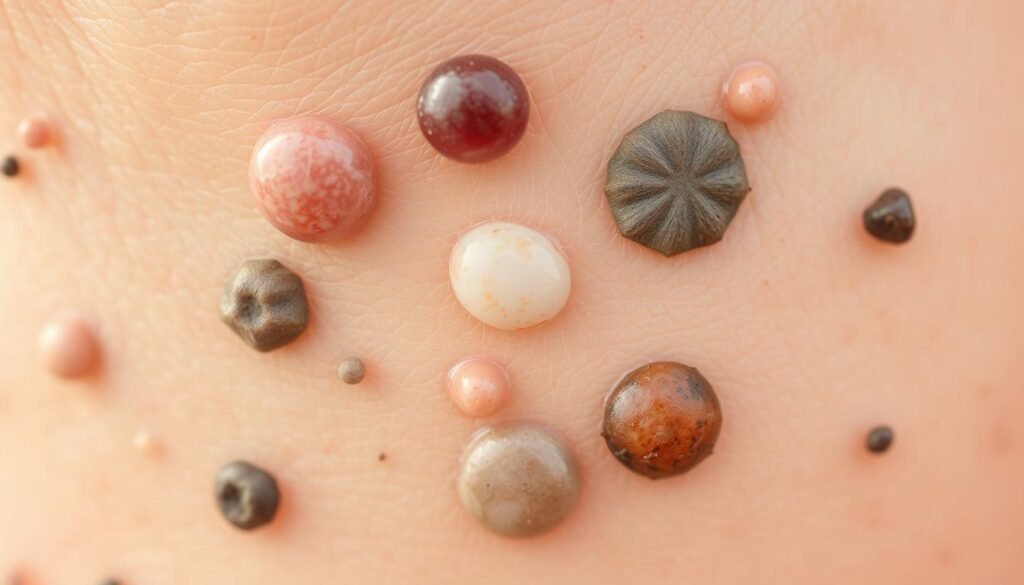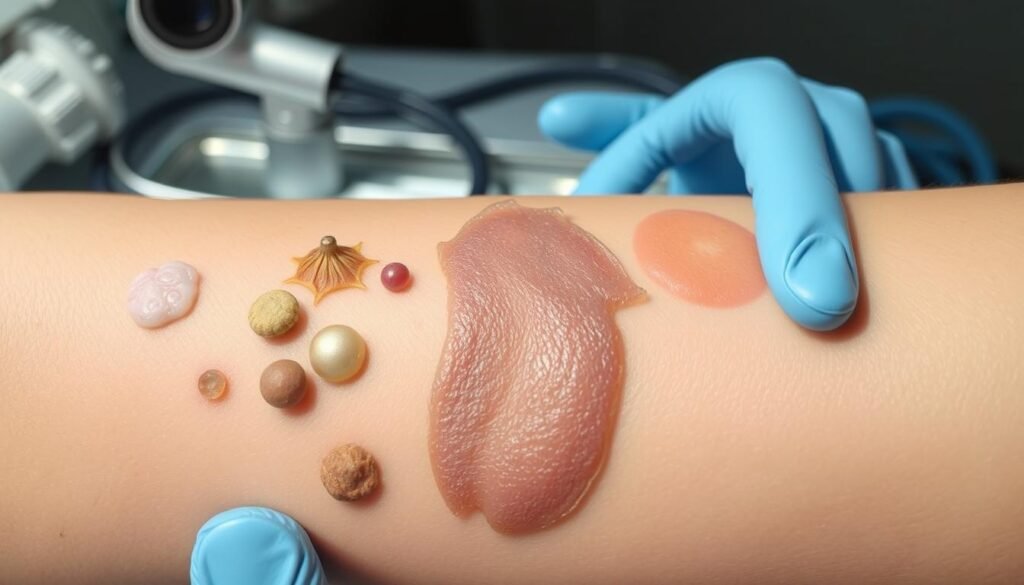Every scar tells a story, and our skin is a living canvas that reflects our journey through life. Understanding skin growth types isn’t just about medical knowledge—it’s about appreciating the unique map of experiences etched into our bodies.
Our skin undergoes remarkable transformations throughout our lifetime. From childhood freckles to mature skin changes, each mark represents a chapter of our personal health narrative. Approximately 1 in 5 Americans will develop skin cancer by age 70, making awareness of skin growth types critical for early detection and prevention.
With moles appearing in 10-40% of the adult population, understanding these skin variations becomes more than a medical necessity—it’s a pathway to self-awareness and proactive health management. We’ll explore the world of skin growths, figuring out which marks are harmless and which might need professional attention.
Key Takeaways
- Skin growths are common and often benign
- Early detection is critical for possible malignant transformations
- Moles and skin marks vary widely in appearance and significance
- Regular skin checks can help identify possible health issues
- Professional medical consultation is recommended for suspicious skin changes
Understanding Different Skin Growth Types
Our skin is a complex organ that can develop various types of growths throughout our lifetime. Some are harmless, while others need medical attention. Knowing the differences is key to keeping our skin healthy.
Benign vs. Malignant Growths
Skin growths fall into two main categories: benign and malignant. Benign growths, like skin tags and warts, are usually non-cancerous and don’t pose a big health risk. They often look like small, raised bumps or discolored patches on the skin.
- Benign growths like skin tags are usually harmless
- Warts are common skin growths caused by viral infections
- Most skin growths do not indicate serious health problems
Common Causes of Skin Growths
Many factors contribute to skin growths. Genetics, hormonal changes, and environmental exposures are big players in their development.
| Cause | Common Skin Growth Types |
|---|---|
| Genetics | Moles, birthmarks |
| Hormonal Changes | Skin tags, cysts |
| Sun Exposure | Seborrheic keratosis, age spots |
Risk Factors and Prevention
While not all skin growths can be prevented, some steps can help. Regular skin checks, avoiding too much sun, and a healthy lifestyle are important.
“Know your skin and monitor changes regularly for early detection of possible issues.”
- Use sunscreen with high SPF
- Perform monthly self-skin examinations
- Consult a dermatologist for professional skin assessments
The Science Behind Skin Growths Development
Exploring the science behind skin growths is fascinating. Our skin is always changing, reacting to our genes and the world around us. This leads to different growth patterns and colors.
Freckles are a great example of this. They form when skin cells called melanocytes react to the sun. People with lighter skin tend to get more freckles because of their genes.
“Skin is a living canvas, constantly reflecting our genetic history and environmental interactions.”
- Melanocytes trigger freckle formation through localized pigment concentration
- Genetic factors significantly influence skin growth characteristics
- UV radiation plays a critical role in skin pigmentation changes
There are many ways skin growths can develop. Moles happen when melanocytes group together. Skin tags appear due to rubbing or hormonal shifts.
| Skin Growth Type | Primary Cause | Typical Age of Occurrence |
|---|---|---|
| Freckles | Sun Exposure | Childhood/Adolescence |
| Moles | Melanocyte Clustering | Before Age 30 |
| Skin Tags | Friction/Hormonal Changes | Middle Age |
Our skin’s ability to grow in different ways is amazing. By understanding these changes, we can keep our skin healthy.
Most Common Benign Skin Growths
Our skin can grow different types of benign growths over time. Knowing about these growths helps us keep our skin healthy. It also tells us when we should see a doctor.
Seborrheic Keratosis: Understanding These Unique Skin Formations
Seborrheic keratosis looks like scaly, brown patches. They often show up in people over 30. These growths can look like warts or even cancerous spots, but they’re not.
- Usually brown or tan in color
- Slightly raised and waxy in texture
- Can appear anywhere on the body
- Do not require medical treatment unless cosmetically concerning
Skin Tags and Moles: Common Skin Variations
Skin tags are soft, small growths that show up where skin rubs together. They’re common in places like the neck, armpits, and groin. About 25% to 46% of adults get them, and they get more common with age.
Cherry Angiomas and Dermatofibromas
Cherry angiomas are tiny, red or blue spots made of blood vessels. They can pop up anywhere but are most common on the trunk and arms. Dermatofibromas, more common in women, often start from insect bites or small skin injuries.
Not all skin growths are cause for concern, but understanding their characteristics can help you monitor your skin’s health.
Even though most benign skin growths are harmless, it’s smart to see a dermatologist if you notice anything odd. This is true for any growth that worries you.
Understanding Moles and Their Characteristics

Moles are interesting spots on our skin that many people have. They are made up of melanocytes, the cells that make melanin. Most moles are safe, but knowing about them helps keep our skin healthy.
Our bodies get moles at different times in life. Here are some important facts about moles:
- Most people have between 10 to 45 moles by age 40
- Moles are usually less than 1/4 inch in diameter
- They can appear in various colors, including brown, black, or bluish
To spot moles that might be a problem, we need to watch them closely. Dermatologists suggest using the ABCDE rule:
- Asymmetry: Irregular shape
- Borders: Irregular or jagged edges
- Color: Multiple colors or uneven coloration
- Diameter: Larger than 6mm
- Evolution: Changes in size, shape, or color
“Regular skin self-exams are your first line of defense in detecting possible skin issues early.” – Dermatology Experts
Be careful with moles that show up after 30 or look different from others. If you notice any odd changes or have questions, see a dermatologist.
Recognizing Skin Tags and Treatment Options
Skin tags are common in the U.S. They are small, soft growths that can appear on the body. They can cause both cosmetic and comfort issues.
About 50 to 60% of adults will get at least one skin tag. These growths often show up in skin folds, like:
- Neck
- Armpits
- Groin
- Eyelids
Identification Features
Skin tags have certain features:
- They are 1 to 5 mm in size, sometimes up to 1-2 centimeters
- They are flesh-colored or brown
- They are soft and slightly raised
- They are attached to the skin by a thin stalk
Available Treatment Methods
| Treatment Method | Procedure Details | Recovery Time |
|---|---|---|
| Surgical Excision | Professional removal by cutting | 1-2 weeks |
| Cryotherapy | Freezing with liquid nitrogen | 3-7 days |
| Electrocautery | Burning with electrical current | 5-10 days |
Prevention Strategies
While you can’t prevent all skin tags, you can lower your risk. Here’s how:
- Maintain a healthy body weight
- Manage blood sugar levels
- Avoid skin friction in folds
- Keep your skin clean
“Understanding skin tags empowers individuals to make informed decisions about their skin health and possible treatments.”
See a dermatologist if you have many or growing skin tags. They might signal a health issue.
Seborrheic Keratosis: Symptoms and Solutions
Seborrheic keratosis is a common skin growth that shows up more often as we get older. It usually starts after age 40. Almost 90% of people over 65 will have at least one of these growths.
Seborrheic keratosis has some key features:
- Appearance of brown, black, or yellow lesions
- Scaly, slightly raised surfaces
- Varying sizes up to 1 inch across
- Potential for multiple growths
Skin growth types like seborrheic keratosis are typically harmless and do not indicate cancer. They often show up on the face, neck, chest, and back.
“Understanding your skin’s changes is key to maintaining overall skin health” – Dermatology Experts
Several factors can lead to seborrheic keratosis:
- Genetic predisposition
- Advanced age
- Sun exposure
- Hormonal changes
Even though these growths are usually harmless, it’s wise to see a dermatologist. They can decide if you need to have them removed. Treatments include cryosurgery, curettage, and electrocautery, done in a doctor’s office.
Age-Related Skin Growth Types
As we get older, our skin changes a lot. It starts to show different growth types. Knowing about these changes helps us take care of our skin better.
Common Age Spots and Their Characteristics
Age spots, or liver spots, start to show up after 40. They are flat, dark patches caused by sun exposure. They often appear on sun-exposed areas like the face, hands, and shoulders.
- Typically tan, brown, or black in color
- Usually harmless but should be monitored
- Range from freckle-sized to larger patches
Senior Skin Changes
Our skin goes through many changes as we age. Women over 45 might see more skin lesions. Seborrheic keratoses, for example, can appear in one to a hundred spots on a person.
*The skin tells a story of our lifetime’s experiences*
Treatment Considerations
Most age-related skin growths are harmless, but it’s important to get them checked. The American Academy of Dermatology suggests yearly skin exams. This helps catch any issues early.
Treatment choices depend on the type of growth. It could be cosmetic treatments or just watching them. Always talk to a dermatologist for advice on your skin.
When to Seek Professional Medical Care

Knowing when to see a doctor for skin growths is key to staying healthy. Skin cancer is the most common cancer in the U.S. It affects 1 in 5 people at some point in their lives.
Our team suggests watching for warning signs that mean you should see a doctor. These signs include:
- Skin growths that change in size or appearance quickly
- Unusual color changes in a mole or skin lesion
- Bleeding or constant itching of skin growths
- New skin growths that don’t heal in a few weeks
Actinic keratosis, a precancerous condition, needs quick medical attention. It shows up as rough, scaly patches and can turn into skin cancer if not treated.
“Early detection is the most effective strategy for managing possible skin health risks.” – Dermatology Experts
Use the ABCDE method for checking suspicious skin growths:
- Asymmetry: Uneven shape of the growth
- Border: Irregular or jagged edges
- Color: Multiple colors or uneven pigmentation
- Diameter: Larger than a pencil eraser (6mm)
- Evolving: Changes in size, shape, or color over time
For the best skin health care, book a check-up with our board-certified dermatologists. We serve Orlando, Clermont, The Villages, Kissimmee, Ocala, Bushnell, and Belleview. Call us at +1(352) 565-7575 to schedule your visit.
Advanced Treatment Options for Skin Growths
Patients facing skin growths have many advanced treatment options. Our guide covers the best ways to handle different skin issues safely and effectively.
Understanding the various medical treatments for skin growths is key. Each method has its own benefits, depending on the growth’s type.
Surgical Procedures
Surgery is often needed for tough skin growths. Here are some important surgeries:
- Local excision for precise removal
- Mohs surgery with high cure rates
- Electrodessication and curettage for small growths
Non-Invasive Treatments
Today’s dermatology offers many non-surgical options for skin growths:
- Cryotherapy using liquid nitrogen
- Laser surgery targeting specific tissues
- Topical chemotherapy medications
- Photodynamic therapy for precancerous conditions
“Advanced treatments offer patients personalized solutions for managing skin growth types with minimal invasiveness.”
Recovery Expectations
Recovery times vary with each treatment. Here’s what patients usually face:
- Minimal downtime with non-invasive procedures
- Potential temporary skin redness
- Follow-up consultations to monitor healing
Always talk to a dermatologist to find the best treatment for your skin growths.
Prevention and Skin Health Maintenance
Keeping your skin healthy means more than just treating problems. It’s about preventing them too. We know how important it is to take care of your skin every day.
Our main strategies for preventing skin issues cover several areas:
- Daily sun protection using broad-spectrum sunscreen with SPF 30 or higher
- Consistent skincare routine tailored to your specific skin type
- Maintaining proper hydration through diet and moisturizing
- Regular skin examinations to detect early signs of skin growth types
Protecting your skin from the sun is key. We suggest using sunscreen every two hours when the sun is strongest. People with fair skin need to be extra careful to avoid damage.
“Prevention is always better than cure when it comes to skin health.”
What you do every day affects your skin. Managing stress, eating right, and avoiding bad habits like smoking can help keep your skin healthy.
| Prevention Strategy | Impact on Skin Health |
|---|---|
| Hydration | Reduces dry skin and supports skin barrier function |
| Nutrition | Provides essential nutrients for skin regeneration |
| Sun Protection | Minimizes risk of skin damage and possible growths |
Don’t forget, catching problems early and preventing them is vital for healthy skin. Check your skin regularly and see a doctor if you notice anything unusual.
Sun Protection and Its Role in Skin Growth Prevention
Keeping your skin safe from UV radiation is key to stopping skin growths and managing freckles. Sunlight can harm your skin, leading to different growths and speeding up aging.
“Sunscreen is the best anti-aging product available today” – Dermatology experts
Understanding sun protection is more than just using sunscreen. Here are important steps to protect your skin:
- Use broad-spectrum sunscreen with SPF 30 or higher
- Reapply sunscreen every 2 hours
- Wear protective clothing and wide-brimmed hats
- Seek shade during peak sunlight hours (10 AM – 4 PM)
Freckles show your skin is sensitive to the sun. They’re not cancerous but mean your skin is more vulnerable to UV damage. Some freckles fade in winter, while others stay all year.
| UV Type | Impact on Skin | Protection Strategy |
|---|---|---|
| UVA | Causes aging and pigmentation | Broad-spectrum sunscreen |
| UVB | Causes sunburn and DNA damage | High SPF sunscreen |
Pro tip: It takes just 10-15 minutes of sun exposure to produce enough vitamin D, so moderate protection is key.
By always protecting your skin from the sun, you can lower the chance of skin growths. This keeps your skin healthy for a long time.
Natural Remedies and Home Care Solutions
Managing skin growth types needs a mix of natural remedies and medical advice. Starting with simple home care is key to good skin health. Aloe vera is a strong natural treatment that helps new cell growth and heals skin issues.
Effective Home Treatments
Studies show that comprehensive skin examinations and natural remedies boost skin health. Coconut oil is great for moisturizing and has anti-inflammatory and antioxidant benefits. Probiotic supplements, as a 2014 study found, can improve skin condition naturally.
Lifestyle Modifications
What we eat affects our skin. The Mayo Clinic says eating lots of fruits and veggies is good for skin health. Drinking eight 8-ounce glasses of water a day, as a 2015 study found, also helps skin. And, not smoking is vital to avoid skin aging early.
Preventive Measures
Prevention is key in managing skin growth types. Using sunscreen with SPF 15 or higher prevents skin damage and cancer. While many use alternative medicine, always talk to a doctor before trying new treatments. Natural remedies can help, but never replace medical advice.




